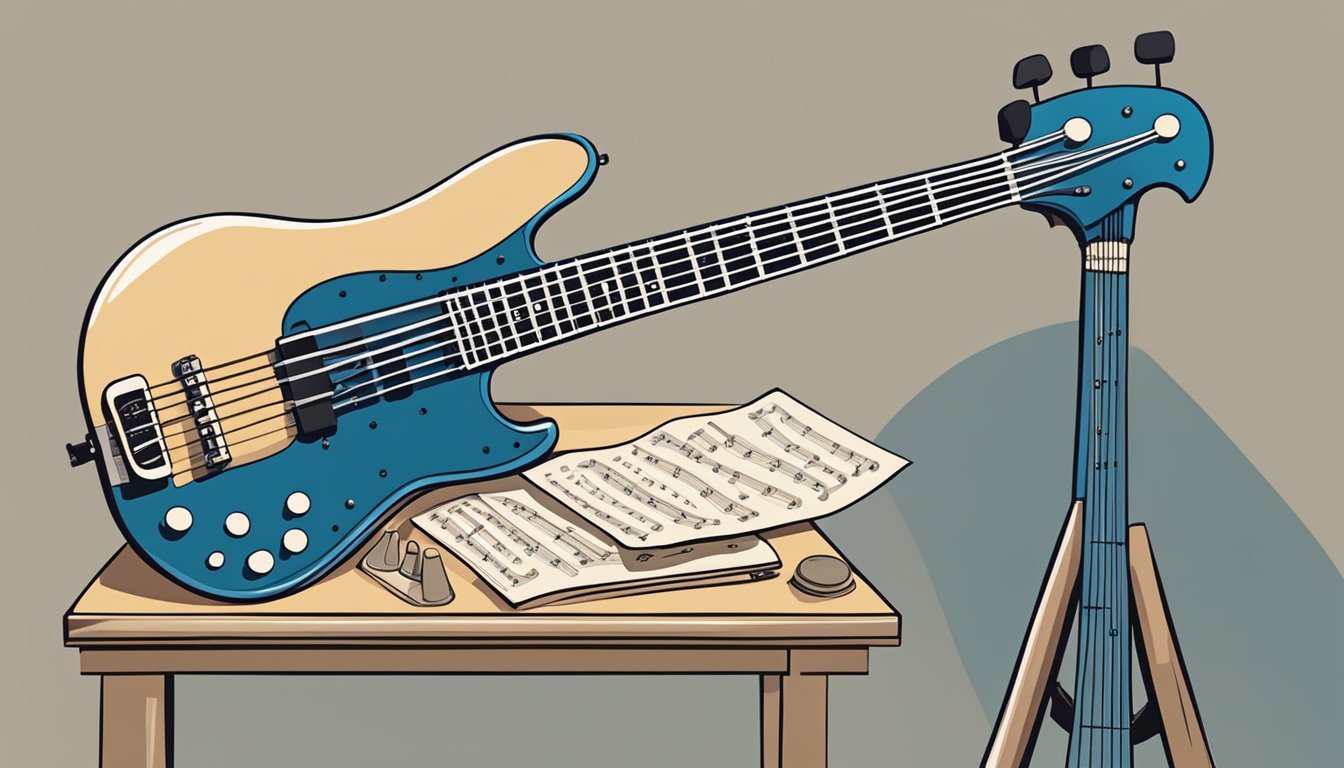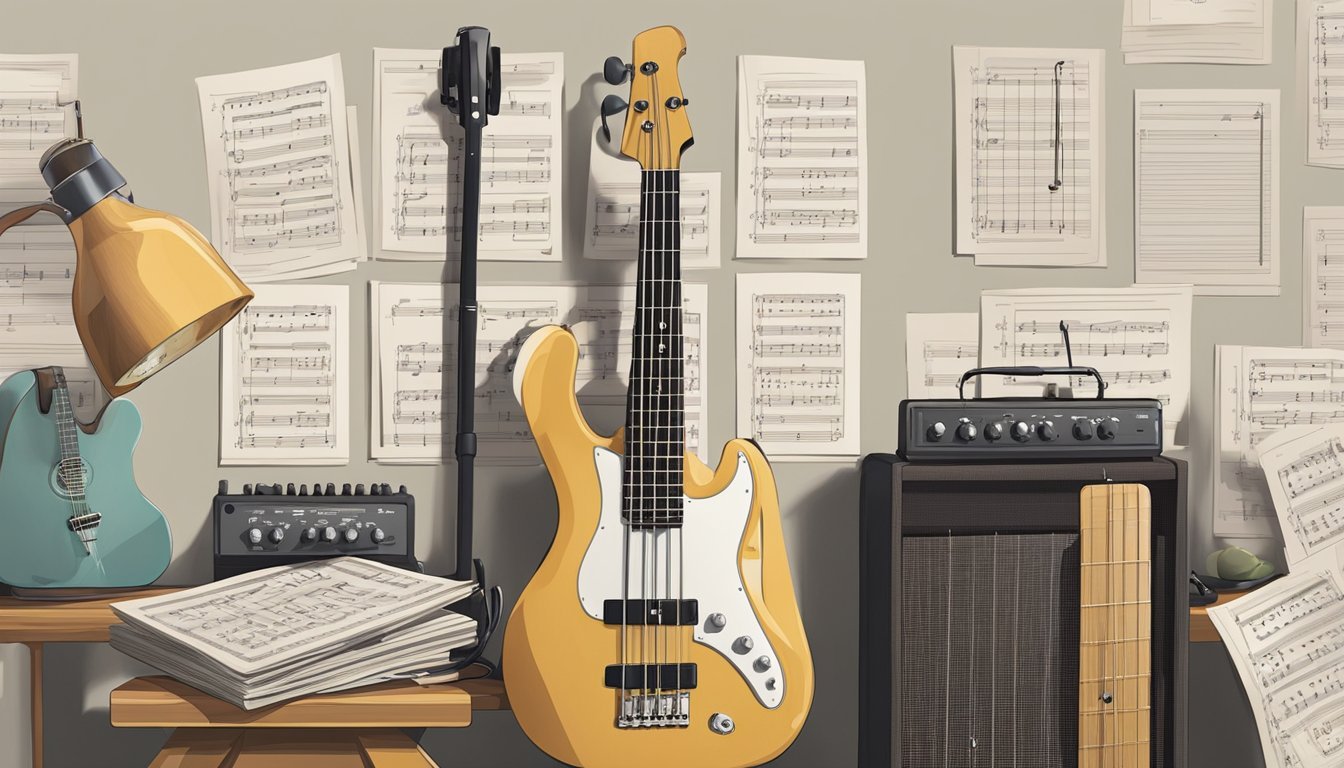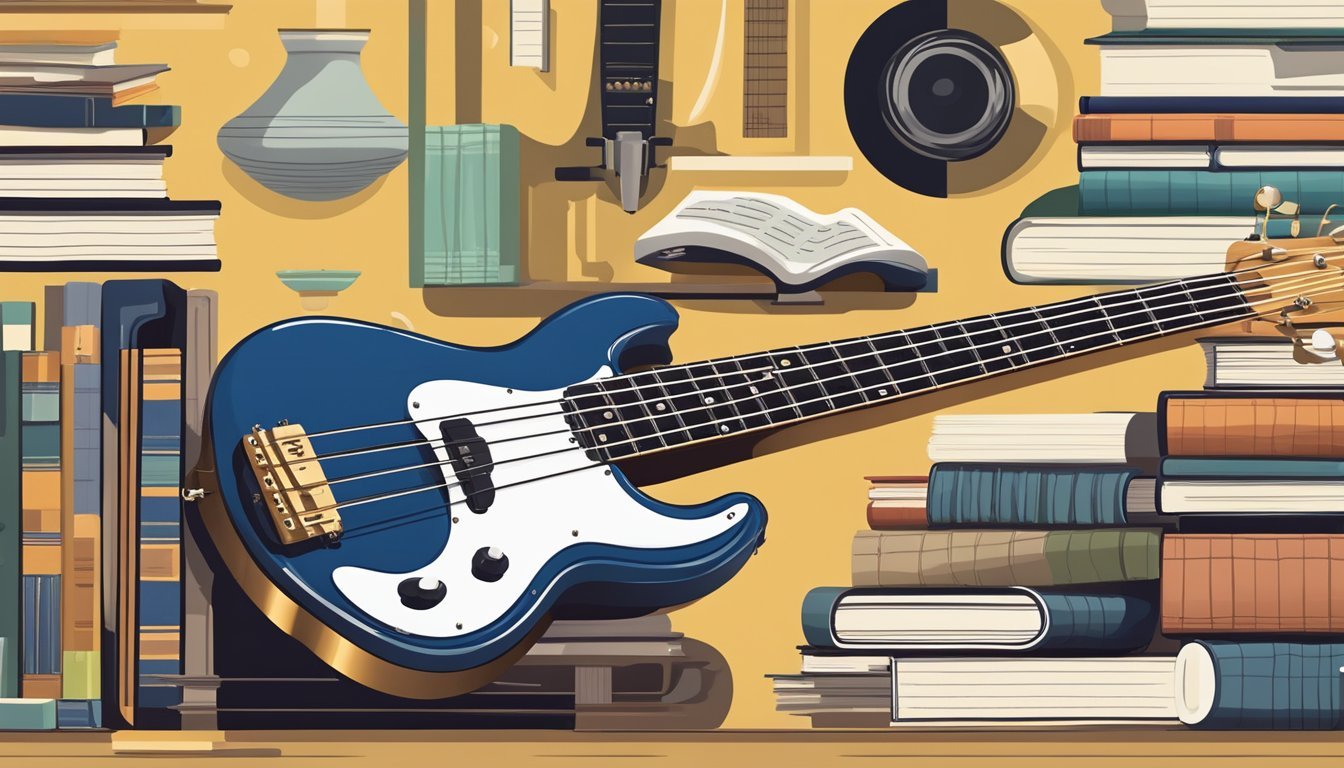Learning bass guitar can be an exciting journey for any music lover.
Many people find it to be easier than other instruments.
The bass guitar offers a unique approach to making music, focusing on rhythm and groove, which can be very rewarding.

As you begin your path with the bass, you’ll discover that practice is key.
With the right resources and tips, you can get started in no time.
Whether you’re playing along to your favorite songs or jamming with friends, the bass guitar allows you to develop skills and enjoy music in a new way.
Key Takeaways
- Learning bass guitar is manageable with practice.
- Focus on rhythm and groove to improve your skills.
- Use available resources to enhance your playing experience.
Getting Started with the Bass Guitar
Starting with the bass guitar can be both exciting and a bit overwhelming.
There are a few key areas to focus on, like choosing the right instrument, learning basic playing techniques, and understanding how to set up your gear for the best sound.
Choosing Your First Bass Guitar
When picking your first bass, consider a four-string bass.
This is the most common type and is great for beginners.
Look for a lightweight electric bass that feels comfortable in your hands.
Brands like Fender and Ibanez offer solid options.
When deciding, think about the sound you want.
A bass with a solid body often has a fuller tone.
Don’t forget to check the neck width; a narrower neck might be easier for your fingers to navigate.
Make sure to grab a bass guitar strap for comfort while playing, too.
Basic Techniques and Playing Styles
To get the most from your bass, you should learn a few essential techniques. Fingerstyle is popular among bassists.
It involves using your fingers to pluck the strings, creating a warm sound.
Another fun technique is slapping, which adds a percussive element to your playing.
Start with simple bass finger techniques to get familiar.
Practice slowly to build your finger strength.
You’ll also want to learn how to use a guitar tuner to keep your bass in tune.
Tuning is crucial for a good sound; use the “E, A, D, G” standard tuning.
Understanding Bass Guitar Setup
Setting up your bass is critical to getting the best sound.
First, know how to tune a bass guitar properly.
This ensures you’re always sounding your best.
Then, check the string height or action.
Lower action means easier playability, while higher action gives a more robust tone.
Consider accessories like a bass guitar case for protection and a good quality guitar tuner to maintain your instrument.
Adjust the pickup heights as well, since they affect volume and tone.
Proper setup helps you play better and enjoy your learning journey more.
Fundamentals of Bass Guitar Playing

To play bass guitar well, you need to focus on a few key skills.
Let’s dive into mastering scales and arpeggios, nailing down basic basslines, and learning chords and progressions.
Mastering Scales and Arpeggios
Learning bass scales is the first step to building your skills.
Start with the major and minor scales, which are essential in music theory.
Major Scale Example:
- C, D, E, F, G, A, B, C
Practicing these scales helps you develop finger strength and dexterity.
Next, explore arpeggios.
These involve playing the notes of a chord separately, like playing the notes of a G major chord: G, B, D.
Use bass tabs to find these scales and arpeggios easily.
Regular practice will help you create groove and better understand rhythms.
Nailing Down Basic Basslines
Once you’re comfortable with scales, it’s time to work on basic basslines.
Start with simple patterns that use root notes.
For example, in a C major chord progression, you would play the bass notes C, E, and G.
Try to lock in with the drummer, focusing on the kick and snare to create tighter grooves.
Listening to your favorite songs and tapping out the basslines can give you ideas for your own.
Experiment with different styles, like rock or funk, and try to mimic popular basslines you hear.
Learning Chords and Progressions
Understanding chord progressions is key to playing bass.
Start by learning basic chords like major and minor shapes.
Here’s a popular progression: C – G – Am – F. You can use these chords to create your basslines.
Tips for Playing Chords:
- Focus on finger placement to avoid buzzing.
- Experiment with rhythmic patterns to make your playing dynamic.
Try playing around with bass chords as well.
You can use simple shapes or play just the root notes to accompany music.
The G chord is another common chord to learn.
Practicing and Improving Your Skills
Getting better at playing bass guitar takes consistent effort and smart practice techniques.
Here are some ways you can boost your skills effectively and explore more advanced playing.
Effective Practice Techniques
When you practice, focus on specific areas to improve.
Start with simple exercises to build your listening skills.
Use a metronome to help with timing.
Playing along with your favorite songs can also improve your groove.
Try breaking your practice into short sessions.
Spend 20 minutes on scales one day, then work on bending and muting techniques the next.
This keeps things fresh and helps you progress faster.
Make a list of techniques to practice.
Here’s a quick example:
- Scales: Major and minor scales.
- Techniques: Bending, slides, and muting.
- Songs: Pick a couple of songs to play along with every week.
Exploring Advanced Techniques
Once you’re comfortable with the basics, consider diving into advanced techniques.
Try adding slides to your playing.
This can create a cool sound and make your bass lines more dynamic.
Experiment with muting to give a cleaner tone and create a staccato effect in your playing.
Learning bending techniques will also enhance your sound by adding expressiveness to notes.
Taking bass guitar lessons can really help here.
A teacher can give you personalized tips based on your goals.
Even online courses can provide structured learning.
Remember to keep challenging yourself.
Working on various styles of music can also expand your skills and sound.
Cultural Impact and Bass Guitar Resources

The bass guitar has shaped music in many ways and offers various resources for learning.
From its role in iconic songs to the tools available for players, understanding these aspects can enhance your musical journey.
The Role of Bass in Music History
Bass instruments have been essential in music for decades.
They lay the foundation in genres like classic rock and funk, creating powerful basslines that drive the rhythm.
Think of famous bass guitarists like Flea from the Red Hot Chili Peppers or Paul McCartney from The Beatles.
Their unique tones and styles showcase how a good bassline can turn a good song into a great one.
Over time, bass guitar strings have evolved, changing both sound and playability.
Today, you can choose from a wide range of string types that affect tone and feel.
Whether you prefer flatwounds for a mellow sound or roundwounds for a brighter tone, the right choice can enhance your playing experience.
Further Learning and Community
To improve your skills, consider taking bass guitar lessons.
Many resources are available online, offering everything from video tutorials to interactive tabs.
Websites like YouTube are packed with instructional content from experienced bassists, helping you master techniques at your own pace.
Joining a community can also be beneficial.
Look for local music groups, forums, or social media groups.
Connecting with fellow bass guitarists can provide tips, inspiration, and even jam opportunities.
Finding a mentor can also speed up your learning process, making it more enjoyable.
Frequently Asked Questions
Learning the bass guitar comes with its own set of questions.
Let’s tackle some of the most common ones to help you get started.
Whether you’re curious about the types of bass guitars available or how to develop your playing technique, it’s essential to address these concerns early on.
Many beginners also find themselves comparing their journey with learning electric guitar as a beginner, as both instruments have unique challenges and rewards.
By understanding the fundamentals of bass playing, you’ll not only build a strong foundation but also enhance your overall musicality.
Is bass easier to learn than regular guitar?
Many people find bass easier to learn than regular guitar.
The bass typically has fewer strings, which means fewer notes to worry about.
Plus, you often focus on rhythm and groove, making it a straightforward starting point for beginners.
What should I focus on first when starting bass guitar?
When you start, focus on learning simple bass lines and basic techniques.
Getting comfortable with the fretboard and understanding rhythm is key.
Practice playing along with songs to develop your timing and feel.
How long does it typically take to become proficient at bass guitar?
Becoming proficient can vary from person to person.
With regular practice, many find that they can play basic songs in a few weeks.
To reach a higher level of skill, it might take several months to a couple of years.
Can you self-teach bass guitar, or should you take lessons?
You can definitely self-teach bass guitar, especially with online resources.
However, taking lessons can provide structure and feedback.
A teacher can help you correct mistakes early on and keep you motivated.
Does having guitar experience make learning bass any easier?
If you’ve played regular guitar, that experience can help you learn bass faster.
You’ll already understand key concepts like finger placement and timing.
Still, bass has its own techniques, so be prepared to adapt.
Is the double bass significantly harder to learn compared to electric bass?
The double bass is generally considered harder to learn than electric bass.
It has a different playing technique and is often played standing.
The size and weight can also take some getting used to, but it offers a rich sound in various music styles.

